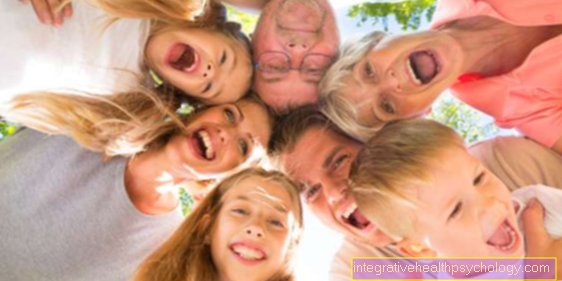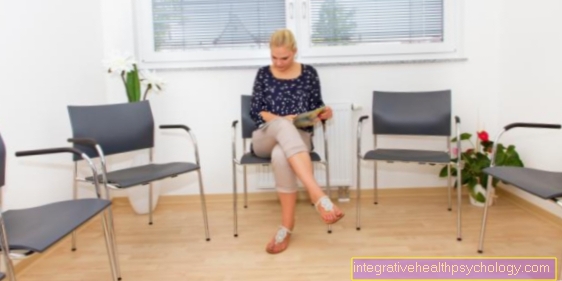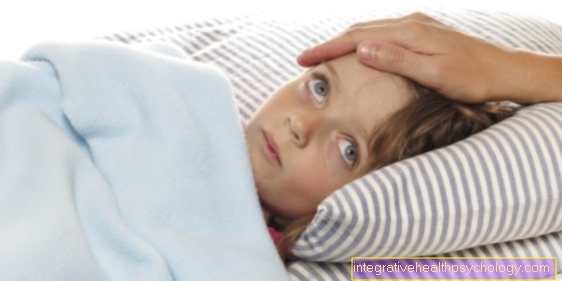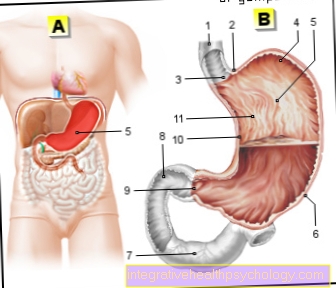kindergarten
A kindergarten is an institution that looks after children between the ages of three and six. These can be public or private institutions. According to the Social Security Code, kindergartens in Germany are obliged to look after, educate and raise children. Accordingly, the kindergarten is not only the first level of the education system, but also a support for families. In the kindergartens, which are responsible for the individual federal states, various educational specialists work, such as educators, social pedagogues, nannies and social assistants.
Also read the article on the topic: raising children

Daily routine in a kindergarten
The daily routine is different in every kindergarten, this is not only down to the kindergarten provider, the management, but also to each individual teacher who leads a kindergarten group. Notwithstanding that, there are structures and / or rituals that can be found in almost every kindergarten. The ritualized processes give the children security and are also important for the parents, as they know exactly when to pick up and bring their child without disturbing them. As a rule, the daily routine in kindergarten consists of a balanced range of exercise, games, experimentation, rest and relaxation. The rest phases and meal times are often tied to specific times.
Read more on this topic: Educational goals
The following schedule can be used as an example for a day-to-day kindergarten program. Between 7 a.m. and 9 a.m., the children are brought to kindergarten by their parents. A morning circle could take place at 9 o'clock, followed by undisturbed free play. During this time, the child is offered opportunities to work creatively, experiment, do gymnastics, etc. A pick-up phase can take place around noon (12 noon). Afterwards there is usually lunch for the children who stay in kindergarten for lunch. This is often rounded off by a rest period in which the children can sleep before another period of free play follows in the afternoon. The children will be picked up again around 4 p.m. As already mentioned, the daily routines of the individual kindergartens can vary greatly, which is why parents should inform themselves about the exact daily routine in advance.
Eating in kindergarten
In a kindergarten there are very different regulations and options on the subject of food. Each kindergarten decides individually how the diet is handled. So it is possible that the children should have already had breakfast at home, that the children should bring their own breakfast or that the kindergarten offers a self-made breakfast together. If breakfast is shared, this is possible either in small groups or in large groups. The question of lunch is dealt with in a similar way. If children have to bring their own lunch, parents should ensure that they eat healthy, if possible without sweets or cakes, as many day-care centers do not like this.
Some daycare centers offer food that you can get from a catering service or cook yourself. Often the food corresponds to a weekly schedule. Furthermore, the range of drinks also varies in every kindergarten. In some, the parents have to provide their child with drinks, in others the kindergarten offers various kinds of drinks. In the kindergarten, the children learn table culture and behavior at the table by eating together. The educators often introduce a common ritual, such as a saying or prayer before meals, and thus give the children a structure. Some kindergartens only offer meals together, in others the child can decide individually when to eat the meal that they have brought with them.
What belongs in the kindergarten backpack?
A lot of different things belong in the kindergarten backpack, this depends very much on the kindergarten you attended. In addition to the food, i.e. the lunch box and the drinking bottle, the children sometimes also need pajamas if they stay in the kindergarten for lunch. For everyday sleeping, some children do not want to miss out on their personal favorite cuddly toy. In addition to pajamas, you can also find a change of clothes in some backpacks, as well as rubber boots or mud pants.
In addition, on hot summer days, you can pack your child's headgear, such as a hat or cap, in the backpack. All in all, however, you have to make sure that the backpack is not too heavy and that it is not filled with objects that the child does not need. The rucksack should fit the child on the back, should not be heavy and have a chest or waist buckle so that the weight is distributed.
What belongs in the kindergarten lunch box?
Every kindergarten regulates the children's food differently. In some kindergartens you cook yourself or the child is fed by the facility, in others, however, the parents have to give their children the food. The question arises as to what belongs in a kindergarten lunch box. Nutritionists recommend a balanced lunch break, which consists of wholemeal flour and is hearty topped. In addition, the child should also be packed some fruit or vegetables so that they also consume sufficient fiber and vitamins.
Food that small children can easily choke on, such as nuts, should be avoided. Sweets such as cakes or gummy bears are not welcome in many kindergartens, but this must first be clarified how the respective kindergarten handles this. Accordingly, soft drinks are also often prohibited. Alternatively, you can provide the child with water or cold fruit tea, which is unsweetened.
When is my child not allowed to go to kindergarten if it is sick?
Kindergarten children have a cold with runny nose and cough around five to ten times a year, which is particularly stressful for parents who work. With such rather mundane illnesses, there are no generally applicable regulations that prohibit parents from sending the child to kindergarten. Parents have to decide for themselves whether it is reasonable for their child to take them to kindergarten or not. Individual kindergartens have their own recommendations for such diseases. As a rule, such children are sent to kindergarten as long as they are fit and alert.
However, if there is a fever, diarrhea, or vomiting in addition to the common cold, pediatricians recommend leaving the child at home. In the case of infectious diseases, against which children are vaccinated in most cases, such as mumps or measles, special precautions are taken to protect children who have not been vaccinated. As long as the child can infect other children, it is not allowed to go to kindergarten. With the individual illnesses, there are different long time intervals in which the child has to stay at home, parents should inform themselves about this at the pediatrician. The kindergarten must be informed that your child has an illness that is listed in the Infection Protection Act. In the case of particularly serious illnesses, such as tuberculosis, parents even have to show the kindergarten a doctor's certificate stating that their child can visit the children again without being at risk of infection for other children.
What should children be able to do when entering kindergarten?
They usually start kindergarten around the age of three. But age is not the only indication of whether the child is ready for kindergarten. The child should be able to play with other children for about an hour or two without the parents. The child must therefore be able to detach itself somewhat from its parents. In addition, it would be an advantage if the child could focus and concentrate on a game for a quarter of an hour. The child should also be able to form short sentences with at least three words and to express them clearly.
Furthermore, the child should hardly need any help with undressing and undressing. Not to be forgotten is a certain social maturity of the child, which is required. This means that the child should also be interested in playing with other children, otherwise they would be overwhelmed in a kindergarten. The issue of keeping children clean is handled very differently from kindergarten to kindergarten. In some kindergartens it is an admission criterion that the child no longer needs a diaper, in others, however, the teachers still change some children. It is best for parents to find out exactly which admission requirements their child must meet at the kindergarten of their choice.
Find out more about the topic: Behavioral problems in children
What should I consider when choosing a kindergarten for my child?
In order to make the right choice of kindergarten for your child, you can pay attention to many things. Most of the characteristics of a good kindergarten become apparent during a short visit or can be inquired about. In this way, the group dynamics can also be recorded during a visit, because these, i.e. the interpersonal relationships between the educators and children, are particularly important. This means that deductions can be made elsewhere if the child is released into a loving environment with a clear conscience.
Find out more about the topic: KITA or daycare provider?
Nevertheless, you should look at the personnel key. This is an average of two teachers for around 25 children and should not be undercut. Parents can also pay attention to the size of the group rooms and determine whether there is enough space available for the child, this is particularly relevant in bad weather, where all children spend hours in the house.
It is also interesting whether the kindergarten has a garden and whether the child can get some fresh air and how the toys and handicraft materials are equipped. Food is also an important point to look out for when choosing a kindergarten. The question arises as to whether the child is fed or whether the parents are responsible for it. Hygiene is just as important, especially in the dining area and in the toilet area. All of this can be found out in advance in a conversation with the kindergarten or during a visit.
Are you interested in this topic? Read our next article below: Care for children and babies - what are they available?
Children with developmental retardation or children with disabilities should be particularly careful when choosing a suitable kindergarten. An integrative kindergarten is ideal, offering measures for individual early intervention in small groups.
What are the costs for a kindergarten?
In Germany, the costs for a kindergarten place are very different. The fees vary not only from municipality to municipality, but also from provider to provider. The decisive factor is whether it is a private or public kindergarten. In most cases, parents have to pay more for a childcare place in a kindergarten from a private provider than from a public provider. In a communal kindergarten, the contribution is usually staggered depending on the parents' salary and is dependent on the number of children per family attending a kindergarten. The costs that the parents have to bear can vary from 50 euros to 200 euros. However, this depends on the state.
Who bears the costs?
The costs of a kindergarten place are made up of the care costs and the meal costs. The child's meal costs must always be paid in full by the parents. In the case of a public provider of a kindergarten, i.e. if the operator is a city, district or municipality, it is very different whether and how many costs the municipality and how many costs the parents have to bear. There are municipalities that take over the costs completely. As a rule, however, the amount of the parents' cost subsidy is calculated depending on the gross annual income, the weekly care expenditure and the number of children per family.
How do I get a kindergarten grant?
A kindergarten allowance is a benefit paid by the employer in addition to normal wages. The employer pays all or part of the costs for the placement of the employee's children who are not yet of school age in a kindergarten or day-care center. Neither employee nor employer have to pay taxes or social security contributions for this benefit. There is no right to such a grant. It is often offered as an additional benefit by employers to make the workplace more attractive. The employer is therefore usually approached about this benefit and it is clarified individually with the employee whether he will be paid a subsidy and if so, in what amount.
How does the acclimatization in a kindergarten look like?
In Germany, the acclimatization of the children in the kindergarten is mostly carried out according to the Berlin model. But it also depends entirely on each individual child. Factors such as siblings in kindergarten and the parents' ability to detach themselves play a major role. The Berlin model consists of five steps. In the first step, parents are informed about everything important and the child's developmental status is recorded. In the next step, the child is accompanied to kindergarten by one of the parents for about one to two hours for three days.
The parent should signal to the child that the kindergarten is a safe place where the child is in good hands. The parents are as passive as possible so that the child also makes contact with the educators. In the third step, a separation attempt of about 30 minutes is usually carried out after the fourth. If this is successful, the fourth step is initiated. The phases of separation continue to expand so that it can stabilize.
In the last step, the child is left alone by the parents in the kindergarten, but remains available at all times. These steps are only completed when the child has got used to the kindergarten situation and allows the educators to comfort him. According to the Berlin model, it takes about three weeks to get used to it, but this varies from child to child. For this reason, parents should take as much time as possible to get used to the job and not decide when to start their job too early.
What is a Montessori Kindergarten?
The Montessori Kindergarten is named after its founder, the Italian doctor and reform pedagogue Maria Montessori (1870-1952). Their motto, and thus also the theme of the Montessori kindergartens, is: "Help me to do it myself." In a Montessori kindergarten, the child is already seen as a whole person. In addition to this guiding principle, Montessori pedagogy is based on the following principles, according to which the educators in the kindergarten act.Education is based on man's knowledge that has been scientifically acquired. The children develop according to their own plan, which shapes their psyche individually.
Every child has their own internal blueprint. In order not to disrupt this plan, a protected environment is required. Furthermore, according to Montessori, children have an absorbing mind, so they absorb their environment in the first years of life and store it in the subconscious. Accordingly, the Kinderarten should offer the children an interesting and varied environment and respond to the needs of the children especially in sensitive phases in which the child can develop specific skills. In the kindergarten, the children receive targeted support in four main areas.
In the first, the child gets exercises from practical life, such as lighting candles, carrying water, etc. Another area is language materials, for example sandpaper letters to feel. In addition, you work with mathematical materials, counting and calculating with the help of pearl necklaces. The last main area is the sensory materials, such as color charts, etc. It is remarkable that the teacher always remains passive and the child is allowed to try out himself and his abilities.
Read more on the topic: Montessori kindergarten







.jpg)




















.jpg)
.jpg)